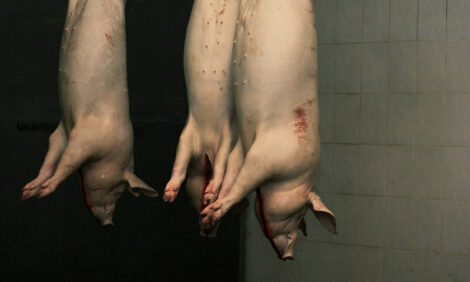



Pork Commentary: Pendulum is Swinging
CANADA - This week's North American Pork Commentary from Jim Long.After 18 months of weekly year over year increases, last week the U.S. marketed 2.307 million head (still a heck of a lot), but 53,000 head fewer then the same week a year ago. We need some breaks. Prices are low with Iowa-Minnesota lean price last Friday at 51.18, which translates in our arithmetic into $40.00 per head losses. We expect year over year weekly marketing’s will begin to be regularly below last year going forward. It’s needed, to get lean hog price appreciation we need smaller marketing’s but thank goodness we are at the very cusp of the impact of the Canada-USA breeding herd liquidation production flow.
Just as importantly, chicken slaughter is falling and U.S. cattle on feed is 5% less than a year ago. Less pork, less beef, less chicken. We estimate the U.S. could have 100 million lbs less total meat per week in December than a year ago, or a decline of 1/3 of a lb per week per capita availability. There is no way that type of decrease in meat availability will not support higher prices. Magnify this with meat production declines in the European Union, Brazil and other countries; the rapid decline in meat protein availability globally is mind-boggling.
Demand
Everyone talks of export demand for meat. The world economic crisis is relevant. It is also relative. We expect, as in the past, all produced meat will be eaten. None of it will be buried in landfill sites. The question is not consumption, but at what price will meat be sold.
As supply declines, we believe meat prices will rise across the board. History tells us America’s meat consumption is not affected by the economy. Maybe they will cut back restaurant visits, but they will continue to eat meat and push demand. In the rest of the world we expect consumers will continue to demand meat. The world has increased meat consumption and we expect, like America, it will hold relatively well. The rest of the world has always paid more for meat than the U.S. They are used to high prices and there is still demand. Russia, for example, has hogs at $350 per head which makes for real expensive pork. Consumers there are still buying all the production.
It’s ugly, it’s hard, it’s disheartening, and it’s no fun being in the hog business the last few months. The good news is the pain of economic losses has cut hog, chicken and beef production. If there was ever a time to take on the economic effects of a global economic issue, it’s now with these cutbacks in supply.
California
The voters of California last weekend voted to eliminate gestation stalls by 2015. The Humane Society of the United States (HSUS) was a prominent proponent of this initiative. The HSUS from our viewpoint is not really interested in changing the production techniques of our livestock or poultry productions. Their main goal is to create a meatless society. The HSUS is shrewd; they pick the production techniques that agriculture has difficulty defending. The HSUS are experts at raising money with emotional issues, while slickly involving media types like Oprah as a vehicle for their message. We are overmatched. The HSUS attacks livestock producers all out. We negotiate. Try to appease. Rationalize. It’s a useless strategy. The HSUS knows in some ways we have the power. U.S. consumers love meat. They eat more than they ever did. Consumers vote everyday when they buy meat. The HSUS comes at us to separate the cultural and historical fact that we are at the top of the food chain with an emotional spin.
We need to stop appeasing, get together and not be taken off our game. It’s the only way; otherwise they will continue to come at us, cherry-picking each issue one at a time. They are our enemy. They want to take away our livelihood and business. We have to be engaged.







